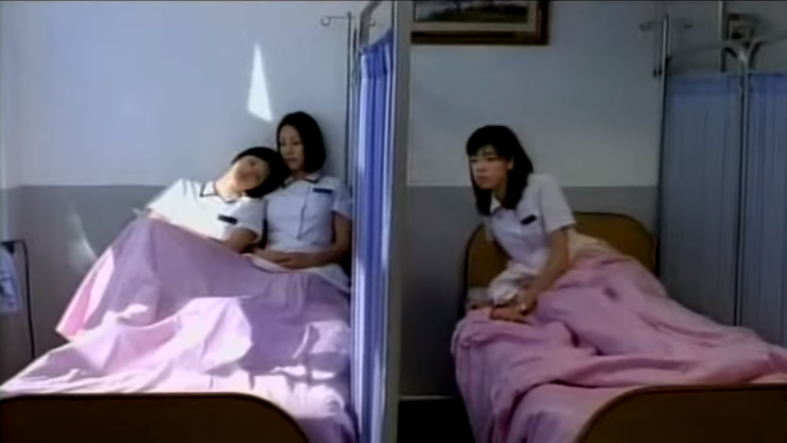Memento Mori
1999

Rating: R
Genre: Drama, Horror
Country: South Korea
Run-Time: 1h 38min
Directors: Kim Tae-yong, Min Kyu-dong
Cast
Park Ye-jin…………..Min Hyo-shin
Kim Min-sun……….Seo Min-ah
Lee Young-jin……..Yoo Shi-eun
Gong Hyo-jin……….Ji-won
I discovered Memento Mori after questioning how many quality modern horrors were released in 1999 if you were to eliminate The Sixth Sense, Audition and The Blair Witch Projecct.
Before my inquiry, I hadn’t actually seen, or even heard of, any of the films in the South Korean Whispering Corridors franchise- a franchise which currently stands at six films, the last being made in 2021, and is likely still growing. But what I’ve read has given me little interest in seeing any of the other films, except maybe the 1998 original…but not because it’s required viewing for its sequel, originally titled Whispering Corridors 2: Memento Mori. The truth is that none of the films in this franchise have any connection outside of being set at an all-girls school (albeit different ones) that will eventually get haunted by the vengeful ghosts of former students.
And from my understanding, many die-hard fans of the Whispering Corridors franchise consider Memento Mori its worst entry, even though cinephiles universally praise it as its best and only really innovative installment. (Obviously, this divisiveness springs from a larger battle between those who like traditional horror versus those who prefer more innovative, arthouse films that are more open to interpretation.)
Released in 1998, the original Whispering Corridors gained notoriety in South Korea after the national school board tried to have it banned because it was troubled by its harsh depiction of teachers using corporal punishment as a disciplinary measure. But despite the controversy, people flocked to see it because it was also the first Korean horror to be made in nearly two decades, being one of the first films to take advantage of the relaxing of strict content restrictions.
After its release, Whispering Corridors became the third highest grossing Korean film of 1998- so a sequel was quickly given the greenlight. But how do you follow-up a film that clearly capitalized on controversy and creative freedoms?
By making a sequel centered around equally controversial material while taking advantage of newer content freedoms.
Whispering Corridors 2: Memento Mori tells the story of a teen lesbian romance, which feels kind of quaint now, but was a huge deal in South Korea during the time since laws allowing queer depictions in film were only passed the year prior.
And though a lot has been made over the years about the significance of Whispering Corridors 2: Memento Mori to queer cinema globally, but of equal interest to fans of modern horror will be its unique use of disjointed storytelling and social commentary on the subtle, and the not-so-subtle, horrors that exist within some educational systems.
The film opens with a shot of the couple, Yoo Shi-eun (Lee Young-jin) and Min Hyo-shin (Park Ye-jin) working on their elaborate shared art diary while a voice over of Hyo-shin recites lines from the type of morbid teen poetry that fills the pages.
Shortly after, we learn that another student, Soh Min-ah (Kim Min-sun), somehow acquired the diary, taking obsessive pleasure reading from it when she feels nobody’s paying much attention to her.
Meanwhile, Min-ah’s friends Ji-Won (Gong Hyo-jin) and Yeon-An (Kim Jae-in) relieve their academic tensions with a camcorder, that is until it is taken away by a paranoid teacher that catches Ji-Won filming his class.
Though Yoo Shi-eun and Min Hyo-shin are the film’s main focus, the truth is that Memento Mori is really about the interconnected lives of all five girls and one handsome, yet extremely problematic teacher named Mr. Goh.
To directors Kyu-dong Min and Kim Tae-yong credit, the film does a tremendous job depicting each of the girl’s distinct personalities. And the actresses who play them, each who have had continued success acting in film, theater and/ or television, really bring these characters to life.Yoo Shi-eun is an athlete who tries to hide the fact that sees going deaf so she will still be allowed to compete. Min Hyo-shin is a brilliant writer, artist and musician, but she also has sociopathic tendencies and needs Shi-eun around to keep her grounded. Ji-Won is a joker that finds trouble and enjoys taking her friends down with her. Yeon-An is a top student, but is jealous of always being overshadowed by Hyo-shin’s creative genius. And Soh Min-ah is kind of the social wallflower who straddles between groups in the hopes of finding a place she feels comfortable.
Memento Mori can be a confusing watch. In order to ensure I understood who was who, I took the time to watch the first half hour twice. It also unfolds using a disjointed timeline that moves back and forth between a period where Yoo Shi-eun and Min Hyo-shin are together and a later time where their relationship is strained so you need to pay attention to who’s holding the diary.
The first two thirds of the film have a realism to it. The handheld camera at times makes it feel more like a documentation of school life. But there also is targeted social commentary on the abusive male teachers.
But the film’s most scathing criticism is aimed at the bizarre practice that allows for a day dedicated to public physical examinations inside South Korean schools. Why do these girls have to subject themselves to these exams with the rest of their classmates watching? Who knows. But this really happened and the film heavily implies that Hyo-shin intentionally skips her exam in fear it will be revealed that she’s pregnant.
Then shortly after a final talk with Shi-eun, who also fears the examination will expose her worsening deafness, Hyo-shin jumps from the rooftop and ends her life.
It’s no coincidence that Kyu-dong Min and Kim Tae-yong connect Hyo-shin’s suicide to an ascinine national school practice that got legislated into law. The exams are a violation of student’s privacy and seem to serve little purpose beyond shaming girls about their bodies.
But how did Hyo-shin, who clearly identifies as a lesbian, get pregnant in the first place? Turns out that there were sociopathic layers to Hyo-shin’s personality that even Shi-eun didn’t fully understand, including a sexual encounter with Mr. Goh.
Which brings us to that ghost story that the Whispering Corridors franchise is supposed to be famous for. After all, the phrase Memento Mori itself is Latin for “remember that you have to die”, but up until this point, the suicide has been the only dying and the horrors been only shown through questionable or abusive school practises.
This last third of Memento Mori goes through a fasinating tonal shift away from its previous realism to offer us something much more surreal and metaphoric, refocusing our gaze on Min-ah, the new owner of the diary. The film’s unusal use of supernatural elements are clearly intented to be psycological. Coincidently, this not unlike how another 1999 film, Takashi Miike’s J-horror classic Audition uses its surereal finale to explore the repressed horrors and desires kicking around in Shigeharu’s head. (Funny how we get two Asian horrors in 1999 that use fragmented, surreal filmmaking for the purpose of deep psychologically introspection.)
And if you find it odd that a horror sequel like Memento Mori would wait until its final act before, arguably, anything supernatural occurs..well yeah- you‘re right. This is a film that goes out of its way to march to its own drum, which is why it’s so ironic that it’s part of a franchise. In fact, its directors publicly stated that they originally intended for Memento Mori to be a ghost story without an actual ghost…that is until the studio forced them to add one. So a ghost was inserted into the film’s final scenes- a move that some criticize as feeling tacked on and out of place. However, others, including myself, appreciate the ending for what it is- a chaotic, yet poetic wrap-up full of heartbreaking reveals that brings the tragic lesbian love story full circle.
For many, Memento Mori is a special movie. There even exists a 6-disc Ultimate Edition with a 186 minute rough cut (not subtitled in English) that apparently adds a few extra characters, provides extra depth to the existing characters and gives Soh Min-ah a new ending. Having seen the film, it makes a lot of sense that parts of it were left on the cutting room floor. The theatrical release works because of its fragmented, non-linear nature, but I still got the sense that there are some missing pieces. For example, it seems like a sixth student was intended to have a larger role in helping Yeon-An to take Hyo-shin down a peg. And I’m sure an even clearer picture would had been painted between Ji-Won’s interactions with Mr. Goh.
Since its release, Memento Mori has gathered a cult following belonging to fans of queer cinema, Korean horror and independent films buffs. It’s an unusual, challenging film that seems like a slap in the face to the more traditional horror franchise it is supposed to belong to. And it is a reminder of how diverse the horror genre can be and how to use horror to shine a spotlight on a country’s questionable social practices.
Memento Mori is a true film gem that today can be appreciated for being ahead of its time. It is a bold, mature, artistic horror released at a time when horror was learning how to walk before the coming modern era. It is an example of a film that shouldn’t exist, at least not as it is, but there it is anyway, refusing to be forgotten.
